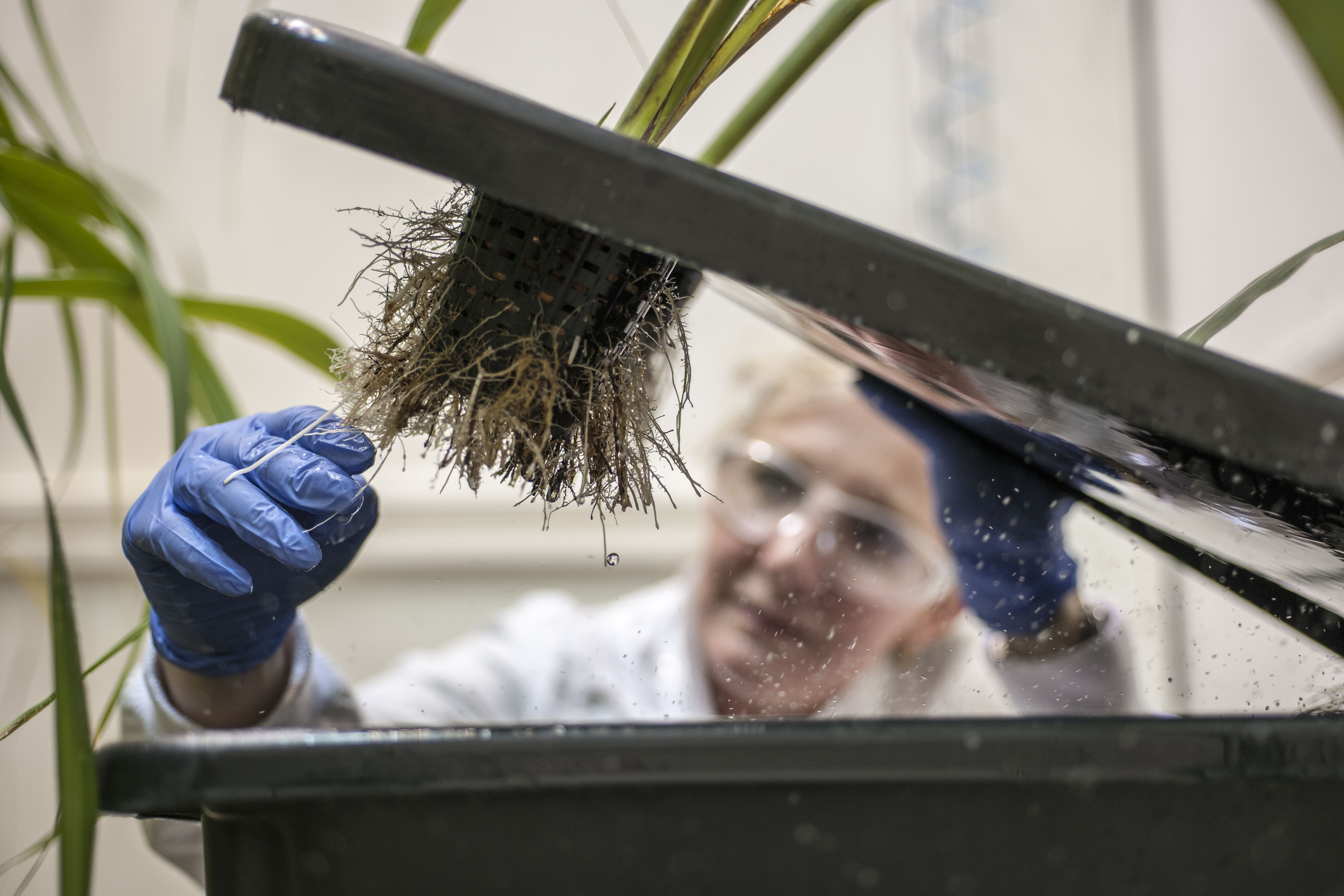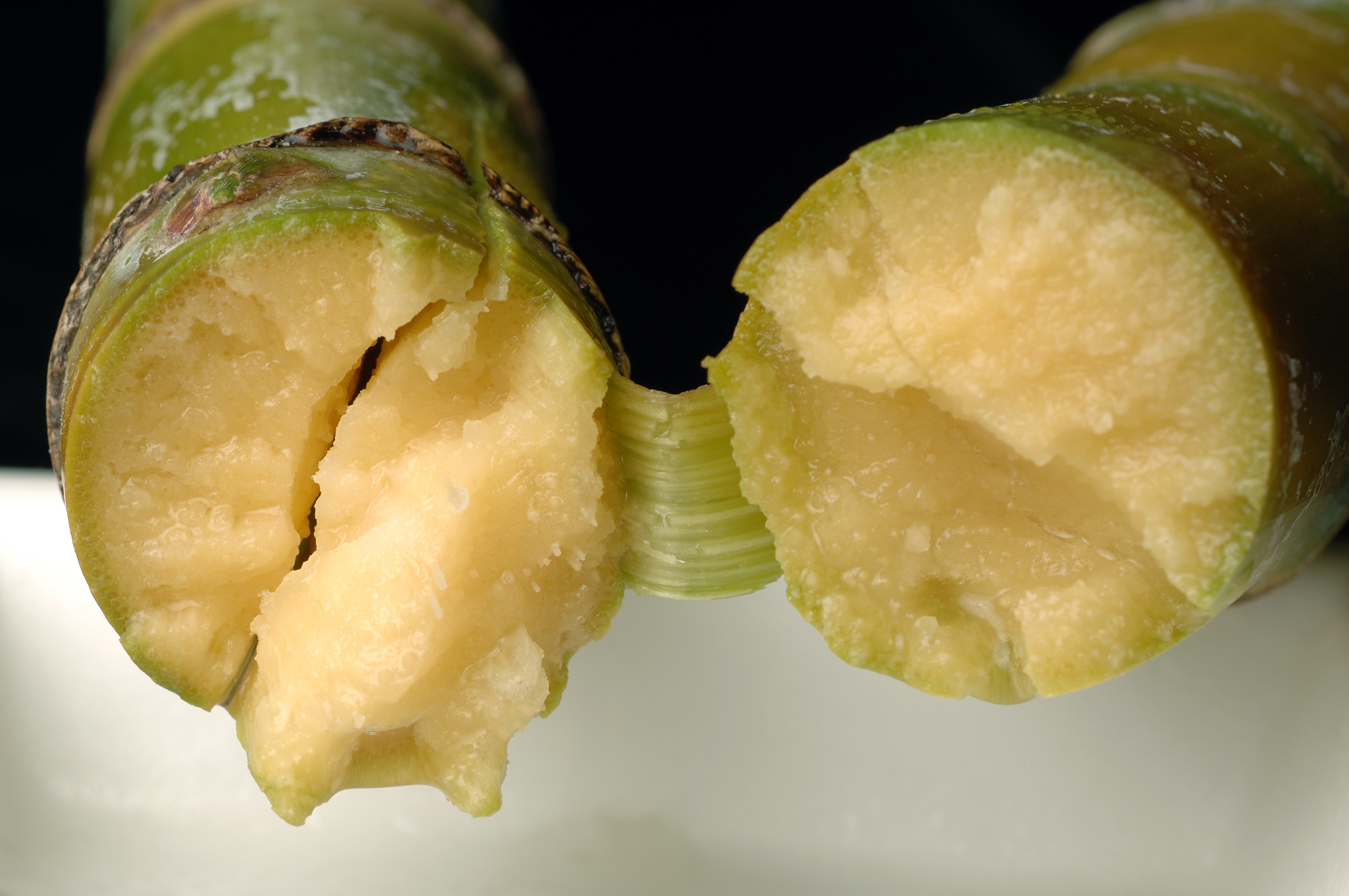Sugarcane produces most of the world's sugar and is being increasingly used for renewable energy supply through production of ethanol and electricity.
Our efforts are mainly focused on improving sugar yields to help support Australia's $1.5 billion sugar industry. Our sugarcane research is undertaken in close collaboration with Sugar Research Australia Ltd (SRA) and the Australian sugar industry.
Harnessing sugarcane genetic diversity
 Modern commercial sugarcane varieties are derived from two species. One, the 'original sugarcane' (Saccharum officinarum), has brought the genes for high sugar content. The other, a wild relative of sugarcane (Saccharum spontaneum), provides hardiness to harsh environments and the ability to ratoon or produce additional profitable crops from re-growth after harvest.
Modern commercial sugarcane varieties are derived from two species. One, the 'original sugarcane' (Saccharum officinarum), has brought the genes for high sugar content. The other, a wild relative of sugarcane (Saccharum spontaneum), provides hardiness to harsh environments and the ability to ratoon or produce additional profitable crops from re-growth after harvest.
There are however many varieties of these two species, and other related species that may be crossed with sugarcane, that have not yet been used in breeding programs. These species are expected to provide a rich source of untapped genes for breeding programs and may provide beneficial traits to cultivated sugarcane.
Our sugarcane researchers are now evaluating plant material produced in collaboration with SRA and research institutes in China. The aim is to identify favourable traits and genes such as:
- resistance to pests and diseases, including sugarcane smut
- biomass yield, offering potential for renewable energy production in the future
- more efficient water use, which is important for the sustainable production of sugarcane.
DNA markers for better sugarcane varieties
DNA markers can flag the presence and location of useful genes or detrimental genes and help breeders to select the best combinations of genes. We have identified a number of DNA markers associated with smut resistance, high sugar content and cane yield. Along with SRA, we are now testing the reliability of these markers for speeding up progress in the breeding program.
The markers have also been used to produce a detailed map of the sugarcane genome that shows how the genes are linked to each other. CSIRO is part of an international consortium to sequence the entire genome of sugarcane. This exciting initiative makes use of cutting-edge technologies and will eventually revolutionise sugarcane breeding.
Faster flowering for new genetic tools
Under natural conditions, sugarcane plants flower only once a year and only at some locations, which reduces opportunities for crossing. We are studying flowering in sugarcane to identify ways of controlling the process.
Making the plants flower more often would enable traits to be combined faster. Understanding the triggers for flowering may also identify ways to prevent flowering in commercial fields, as this can reduce sugar yields.

Increasing sugar accumulation
Sugarcane leaves produce sugar using carbon dioxide and sunlight, and transport it to the storage tissue in the stalk. The sugar is extracted from the stalks at the sugar mill.
By studying the unique features of the sugarcane stalk that allow it to store very high concentrations of sugar, we aim to identify ways of increasing the yield. A model for the pathways of sugar movement into the storage tissue has been developed and is now being tested to identify control points.
We have also discovered new ways of directing proteins into this storage tissue using experimental genetically modified sugarcane plants.
Baselines to aid regulation of GM sugarcane
As in many other crop species, genetically modified (GM) varieties of sugarcane are forecast to improve profitability by reducing input costs, increasing sucrose yield or introducing novel products. GM sugarcane is being developed by a number of Australian and international research organisations and companies.
Before the products from these varieties can be used, they will need approval from the Office of the Gene Technology Regulator, which ensures GM plants are safe for humans and the environment and from Food Standards Australia and New Zealand which regulates food safety. We are conducting research to provide baseline information on sugarcane that will be used for assessing GM varieties.
For food safety approval, we have analysed the nutritional content of the sugarcane stalk from current commercial varieties. The work will enable GM sugarcane to be compared against this baseline for regulatory purposes.
Research to ensure that future GM sugarcane varieties will be released without any detrimental environmental effects is focussed on the reproductive biology of sugarcane and related species. We have measured pollen flow to form hybrid seeds and the likelihood that seeds can grow and establish plants outside cultivation.
We are also studying why wild canes are a weed problem in some parts of the world. This information will help Australia to safely manage GM sugarcane in the future.
Sugarcane produces most of the world's sugar and is being increasingly used for renewable energy supply through production of ethanol and electricity.
Our efforts are mainly focused on improving sugar yields to help support Australia's $1.5 billion sugar industry. Our sugarcane research is undertaken in close collaboration with Sugar Research Australia Ltd (SRA) and the Australian sugar industry.
Harnessing sugarcane genetic diversity
Modern commercial sugarcane varieties are derived from two species. One, the 'original sugarcane' (Saccharum officinarum), has brought the genes for high sugar content. The other, a wild relative of sugarcane (Saccharum spontaneum), provides hardiness to harsh environments and the ability to ratoon or produce additional profitable crops from re-growth after harvest.
There are however many varieties of these two species, and other related species that may be crossed with sugarcane, that have not yet been used in breeding programs. These species are expected to provide a rich source of untapped genes for breeding programs and may provide beneficial traits to cultivated sugarcane.
Our sugarcane researchers are now evaluating plant material produced in collaboration with SRA and research institutes in China. The aim is to identify favourable traits and genes such as:
- resistance to pests and diseases, including sugarcane smut
- biomass yield, offering potential for renewable energy production in the future
- more efficient water use, which is important for the sustainable production of sugarcane.
DNA markers for better sugarcane varieties
DNA markers can flag the presence and location of useful genes or detrimental genes and help breeders to select the best combinations of genes. We have identified a number of DNA markers associated with smut resistance, high sugar content and cane yield. Along with SRA, we are now testing the reliability of these markers for speeding up progress in the breeding program.
The markers have also been used to produce a detailed map of the sugarcane genome that shows how the genes are linked to each other. CSIRO is part of an international consortium to sequence the entire genome of sugarcane. This exciting initiative makes use of cutting-edge technologies and will eventually revolutionise sugarcane breeding.
Faster flowering for new genetic tools
Under natural conditions, sugarcane plants flower only once a year and only at some locations, which reduces opportunities for crossing. We are studying flowering in sugarcane to identify ways of controlling the process.
Making the plants flower more often would enable traits to be combined faster. Understanding the triggers for flowering may also identify ways to prevent flowering in commercial fields, as this can reduce sugar yields.
Increasing sugar accumulation
Sugarcane leaves produce sugar using carbon dioxide and sunlight, and transport it to the storage tissue in the stalk. The sugar is extracted from the stalks at the sugar mill.
By studying the unique features of the sugarcane stalk that allow it to store very high concentrations of sugar, we aim to identify ways of increasing the yield. A model for the pathways of sugar movement into the storage tissue has been developed and is now being tested to identify control points.
We have also discovered new ways of directing proteins into this storage tissue using experimental genetically modified sugarcane plants.
Baselines to aid regulation of GM sugarcane
As in many other crop species, genetically modified (GM) varieties of sugarcane are forecast to improve profitability by reducing input costs, increasing sucrose yield or introducing novel products. GM sugarcane is being developed by a number of Australian and international research organisations and companies.
Before the products from these varieties can be used, they will need approval from the Office of the Gene Technology Regulator, which ensures GM plants are safe for humans and the environment and from Food Standards Australia and New Zealand which regulates food safety. We are conducting research to provide baseline information on sugarcane that will be used for assessing GM varieties.
For food safety approval, we have analysed the nutritional content of the sugarcane stalk from current commercial varieties. The work will enable GM sugarcane to be compared against this baseline for regulatory purposes.
Research to ensure that future GM sugarcane varieties will be released without any detrimental environmental effects is focussed on the reproductive biology of sugarcane and related species. We have measured pollen flow to form hybrid seeds and the likelihood that seeds can grow and establish plants outside cultivation.
We are also studying why wild canes are a weed problem in some parts of the world. This information will help Australia to safely manage GM sugarcane in the future.
